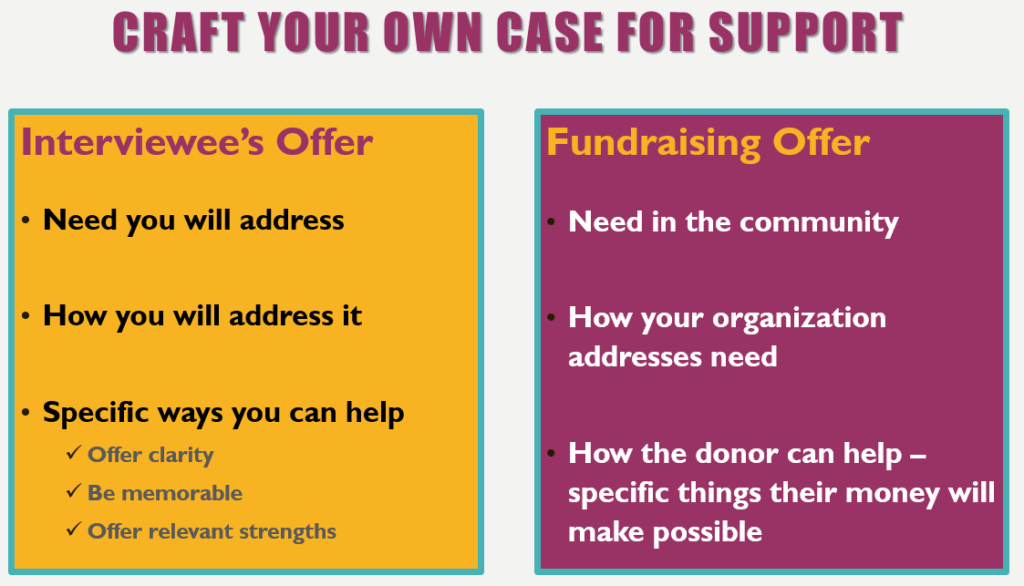
Consider the value–for–value exchange.
When my daughter-in-law was interviewing for a job, she asked me for some advice. Here is what I found myself telling her:
Don’t focus on your needs. Focus on the employer’s needs.
Why are they hiring?
What problems do they need you to solve?
Which of your skills are they particularly looking for?
Can you describe to them how you might use these skills to help them?
Can you give a specific example, perhaps by telling a story, showing exactly how you’ll help them?
Are you clear what their values are?
CAN YOU DESCRIBE HOW YOU AND YOUR WOULD-BE EMPLOYER (DONOR) SHARE THESE VALUES?
I realized this is the exact same advice I give to fundraisers!
“Ask not what your donor can do for you, but what you can do for your donor.”
Meet your donors’ needs.
This is the heart of all effective fundraising, and the following should be your daily mantra.
“Today I will meet my donor’s need by…”
In fact, if you really want to become effective at your job, you will adopt this mantra for your interactions with co-workers as well.
“Today I will meet my colleague’s need by…”
This shift in your stance and approach may not seem like a lot, but it’s actually a game changer. By beginning with putting yourself in the shoes of another, you automatically open yourself to giving and receiving gifts. And I often say if you want gifts you must give them.
Before you engage in any fundraising strategy, ask yourself:
- What might this do for the donor?
- How will they perceive this?
- How might this help them?
- Will this make them want to choose us, as opposed to another charity?
- After they choose to make a philanthropic gift here, how will this make them feel?
- Will giving here provide the donor with a warm glow, and a sense of meaning and fulfillment?
- Will this be the beginning of a beautiful relationship?
- Will it be evident that, moving forward, we will become great partners in this important endeavor?
- Are our values aligned, and are we like-minded souls?
Don’t make it all about you.
No matter how often I tell people this, I still find well over a majority of nonprofits engage in ‘Me-Me-Me’ fundraising and marketing (or ‘We – We – We,’ or ‘Our – Our – Our’).
It’s tempting to brag about yourself. You think somehow this will reassure people they’re making a good decision in engaging with you.
But you telling people how awesome you are, doesn’t make it so.
Nor does it make it particularly believable.
You may think you’re there to sell a product, whether that product be yourself as a potential hire or your nonprofit as a potential philanthropic option, but that’s not the case.
That’s not at all why you’re there.
That’s not at all what a potential employer is looking for, nor is it what a potential donor seeks.
You’re there to sell a benefit.
Show the donor how they can be the best they can be.
Don’t hold a mirror up to yourself.
Rather, show your donors their own reflection in the mirror.
Help them see themselves as they would like to see themselves.
As the hero.
Help them feel confident. They can do this, and it will truly make a demonstrable difference!
Help them trust you. Help them overcome any hesitations they may have.
Show them how by choosing you they can be a true winner.
Because they won’t have purchased you as a “product;” they’ll have purchased you as a “benefit” to themselves.
Help them feel benefited.
Help them feel good.
Showcase your strengths/craft your ‘case’ for support.
 I told my daughter-in-law to go into the interview with clarity as to her key strengths. I told her that whatever the interviewer asked her, she should be prepared to answer in a way that clarified and demonstrated these key strengths.
I told my daughter-in-law to go into the interview with clarity as to her key strengths. I told her that whatever the interviewer asked her, she should be prepared to answer in a way that clarified and demonstrated these key strengths.
I asked her:
- “What’s your secret sauce?
- What makes you stand out from the competition?
- What’s your unfair advantage?”
Donors want to know the exact same things about your nonprofit. They want clarity. They want specificity.
Too often when we interview for jobs, or when we try to showcase ourselves to prospective supporters, we try to be someone we are not. We try to be who we think they are looking for, rather than who we are.
This is a recipe for disaster.
Think about value – for – value.
When you’re vague about what you do or who you are, there’s no real substantial value being expressed.
In the end, this will not be a match made in heaven.
You can’t match nothing-for-nothing.
No one will be happy. No one will be a true winner.
There’s little point in securing a job you don’t really want. [Unless, of course, you really truly need it to survive– in which case you’re rightly thinking about yourself, and not the employer (making the rest of these points moot).]
Similarly, there’s little point in securing a one-time transactional donation you won’t be able to repeat and/or sustain over the long term.
Short-term hires, and one-time donations, cost you (the employer or the nonprofit) real money. Only 19% of first-time donors renew, and the cost to raise a dollar can average $1.25. Groundbreaking research from Penelope Burk found average turn-over of development staff is just 16 months, and replacing these professionals averages $127,650 in direct and indirect costs.
These are not value-for-value exchanges. There are the opposite of beneficial — even though, at the time of the transaction, it might seem like a good deal.
Think about what success will really look like.
A ‘deal’ isn’t a deal if in the end neither party really gets what they value.
If you know what your donor (or potential employer) values, then you can offer it to them.
If you’re just stabbing around in the dark, letting folks know you are ‘good,’ you won’t get very far. Because you simply won’t stand out. You won’t make the kind of impression you need to make.
Think specifically about what you (as a potential employee or charitable recipient) are offering of value.
Talk about the value you offer.
There are all sorts of things a potential donor may receive in return for their donation. The value they exchange is money. The value you return is generally intangible. A feel-good. A sense of having fulfilled a moral or religious obligation. A sense of having given back, or being able to pay it forward. A favor to a friend. Even a desire to have a name on a building.
Your job is not to judge what your donor values. Simply be aware of what it might be.
Whatever the value is in any particular circumstance, that’s the real reason the gift is given.
So… next time you interview with a potential employer or donor, make your best ‘case’ by focusing on shared values.
Be ready with examples to show you’re good match for what they are seeking.
Lead from their perspective — their needs and problems — and convey specifically how you’re well-suited to offer a desirable solution.
Relate anecdotes/stories that demonstrate how you enact these values.
Hold up a mirror to showcase how awesome they will become when they partner with you.
Never forgot your daily mantra: “Today I will meet my donor’s need by…”
Want to learn more about creating a compelling annual case for support?
 If you’re ignoring any of the elements that go into making your appeal effective you’re ignoring your organization’s future. Grab Anatomy of a Fundraising Appeal Letter + Sample Template. This is a simple, yet incredibly thorough, 62-page step-by-step guide to crafting a killer appeal letter or email appeal. If you follow these guidelines, you’ll raise more money.
If you’re ignoring any of the elements that go into making your appeal effective you’re ignoring your organization’s future. Grab Anatomy of a Fundraising Appeal Letter + Sample Template. This is a simple, yet incredibly thorough, 62-page step-by-step guide to crafting a killer appeal letter or email appeal. If you follow these guidelines, you’ll raise more money.
As with all Clairification products, this comes with a 30 day, no-questions-asked, 100% money-back guarantee. You’ve nothing to lose, and much to gain.
To your success!
Image by Mari Ana from Pixabay.




